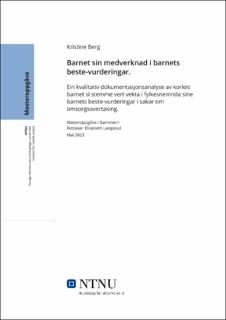| dc.contributor.advisor | Langsrud, Elizabeth. | |
| dc.contributor.author | Berg, Kristine. | |
| dc.date.accessioned | 2023-07-11T17:31:52Z | |
| dc.date.available | 2023-07-11T17:31:52Z | |
| dc.date.issued | 2023 | |
| dc.identifier | no.ntnu:inspera:138896764:92929065 | |
| dc.identifier.uri | https://hdl.handle.net/11250/3078136 | |
| dc.description.abstract | I denne masteroppgåva har eg undersøkt korleis barnet si stemme vert inkludert i fylkesnemnda si vurdering av barnets beste, med problemstillinga; Korleis blir barnet si stemme vekta i fylkesnemnda sine vurderingar om kva som er barnets beste i saker om omsorgsovertakingar? Studien er gjennomført ved å nytte fylkesnemnda sine vedtak i saker om omsorgsovertaking frå perioden januar 2021 til oktober 2022, i aldersgruppa 12-14 år. Utvalet inkluderer 14 vedtak, og er henta frå Lovdata-PRO. Metoden for oppgåva er ei kvalitativ dokumentasjonsanalyse.
Det har dei siste 15 åra vore eit auka fokus på barns rettigheiter, med eit søkjelys retta mot barnet sin rett til å delta og fortelje sine synspunkt i saker som omhandlar dei. Ein tanke med studien var difor å forsøke å løfte fram dette fokuset, og sjå om barnet sine meiningar faktisk vert inkludert i vurderinga i tilstrekkeleg grad. Min vitskapelege ståstad har vert prega av eit kritisk blikk, med fokus på om samfunnsmessige institusjonar er gode nok. Forskingsspørsmåla, analysen og diskusjonen er delt inn i tre delar; barnets beste, barnet si stemme og om barnet. Vurderinga av barnets beste og barnet sine meiningar er i hovudfokus, og områda er analysert separert for å tydeleggjere om det er ein samanheng. Delen om barnet visar til nemnda sine skildringar av barnet, og om dette har ein påverknad på barnets medverknad. Diskusjonen vert underbyggja av kunnskap og forsking på feltet, samstundes som eg har nytta sosialkonstruksjonisme og Foucault sin maktteori for å forklare nokre fenomen.
Mitt viktigaste funn var at barnets beste-vurderinga ikkje er noko som skjer direkte, men heller fungerer som ein diskusjon der nemnda løftar fram ulike moment for å slutte eit vedtak. Barnets stemme tar lite del i denne diskusjonen. I sakene vert barnet si stemme i ulik grad dokumentert, og nemnda fortel i dei fleste høver om stemma er tillagt vekt eller ikkje. Det som likevel er manglande er barnet si stemme som posisjon i diskusjonen. Nemnda vektar i større grad andre element som foreldre sin omsorgskompetanse og barnets omsorgsbehov, og dette resultatet kan bli underbyggja i mine resultat, lovverket og andre forskingsprosjekt. Det opplevast av vedtaka som at det ikkje er god nok kvalitet i korleis barnet si stemme blir brukt i nemnda sine diskusjonar. For som nemnt er det denne diskusjonen som fører til ei vurdering av barnets beste. | |
| dc.description.abstract | In this master thesis I have researched how a child’s voice has been accounted for in the county boards evaluation of what is the child’s best interest, with the issue; Does a child´s voice carry weight in the County Board´s assessments of what is in the best interests of the child in cases of custody takeover? This study is made by using the County Board´s decisions in cases of custody takeovers from the period of 2021-2022, with the age group being 12-14 years old. This includes 14 articles of associations and are retrieved from Lovdata-PRO.
Over the past 15 years, there has been an increased focus on children´s rights, including the child´s right to participate and express their views in matters that concern them. The purpose of this study was to shed light on this focus and to examine whether the child´s opinions are included to a sufficient extent in the assessment. My scientific standpoint has been influenced by a critical perspective, focusing on whether societal institutions are good enough. The research question, analysis, and discussion are divided into three parts: the child’s best interest, children´s voice, and about the child. The assessment of the best interest of the child and the child´s opinions are the focus, and the areas are analysed separately to clarify if there Is a connection. The section about the child refers to the Board´s descriptions of the child, and whether this has an impact on the child´s participation. This discussion is supported by knowledge and research in the field, while I have also used social constructionism and Foucault´s theory of power to explain some phenomena.
My most important finding was that the evaluation of the best interest of the child do not occur directly, but rather function as a discussion where the Boards raise various elements to reach a decision. The child´s voice plays a small part in this proses. In the cases, the child´s voice was documented to a varying degree, and the Board usually informs whether it has been given weight or not. However, what is missing is the child´s voice as a position in the discussion, where the board weighs other elements such as parental competence and the child´s care needs, and this result is supported by my findings, legislation, and other research projects. The analysis shows that the child´s voice is included in the resolutions but is less often highlighted as a point of discussion when assessing the child´s best interests. Because as mentioned, it is the discussion that leads to an assessment of the best interest for the child. | |
| dc.language | nno | |
| dc.publisher | NTNU | |
| dc.title | Barnet sin medverknad i barnets beste-vurderingar: Ein kvalitativ dokumentasjonsanalyse av korleis barnet si stemme vert vekta i fylkesnemnda sine barnets beste-vurderingar i sakar om omsorgsovertaking. | |
| dc.type | Master thesis | |
